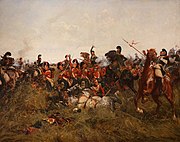| 42nd (Royal Highland) Regiment of Foot | |
|---|---|
 | |
| Active |
1661-1718 1725-1881 |
| Country |
Scotland Kingdom of Great Britain United Kingdom of Great Britain and Ireland |
| Branch | British Army |
| Type | Line Infantry |
| Nickname(s) |
Black Watch Forty-Twa Black Jocks |
| Motto(s) | (Scotland's) Nemo me impune lacessit |
| Engagements |
War of Austrian Succession French and Indian War American War of Independence Peninsular War Indian Mutiny |
| Battle honours |
Egypt 1801 Corunna Peninsula Waterloo Alma, Sevastopol Lucknow Ashanti |
The 42nd (Royal Highland) Regiment of Foot was a Scottish infantry regiment in the British Army also known as the Black Watch. Originally the 43rd Highlanders they were renumbered to the 42nd in 1748 on the disbanding of the existing Oglethorpe's 42nd Regiment of Foot allowing the regiment to assume that number as its own.[1] In 2006 the Black Watch became part of the Royal Regiment of Scotland.
History[]
Early history[]
After the Jacobite rising of 1715 the British government did not have the resources or manpower to keep a standing army in the Scottish Highlands. As a result, they were forced to keep order by recruiting men from local Highland clans that had been loyal to the Whigs. This proved to be unsuccessful in deterring crime, especially cattle rustling. Therefore Independent Highland Companies (of what would be known as the "Black Watch") were raised as a militia in 1725 by General George Wade to keep "watch" for crime.[2] He was commissioned to build a network of roads to help in the task.[3] The six Independent Highland Companies were recruited from local clans, with one company coming from Clan Munro, one from Clan Fraser, one from Clan Grant and three from Clan Campbell. These companies were commonly known as Am Freiceadan Dubh, or the Black Watch, this name may well have been due to the way they dressed.[4] Four more companies were added in 1739 to make a total of ten Independent Highland Companies.[5]
The ten Independent Highland Companies of "Black Watch" were officially formed into the "43rd Highland Regiment of Foot", a regiment of the line in 1739.[6] It was first mustered in 1740, at Aberfeldy, Scotland. The Colonel was John Lindsay, 20th Earl of Crawford and the Lieutenant-Colonel was Sir Robert Munro, 6th Baronet. Among the Captains were his next brother, George Munro, 1st of Culcairn (also a Captain of an Independent Company raised in 1745) and their cousin John Munro, 4th of Newmore who was promoted lieutenant-Colonel in 1745 (in place of Sir Robert who went on to command the 37th (North Hampshire) Regiment of Foot). The other Captains of the 43rd were George Grant, Colin Campbell of Monzie, James Colquhoun of Luss, John Campbell of Carrick, Collin Campbell of Balliemore and Dougal Campbell of Craignish.[7]
First action and Mutiny[]
The regiment's earliest days were inauspicious: ordered to London in 1743 for an inspection by King George II, rumours flew that they were to be shipped to the West Indies to fight in the War of Austrian Succession, and many left for Scotland. They were recaptured, three of the leaders shot in the Tower of London, and the remainder of the regiment shipped to Flanders. The regiment's first full combat was the disastrous Battle of Fontenoy in Flanders in 1745, where they surprised the French with their ferocity, and greatly impressed their commander, the Duke of Cumberland. Allowed "their own way of fighting", each time they received the French fire Col. Sir Robert Munro ordered his men to "clap to the ground" while he himself, because of his corpulence, stood alone with the colours behind him. For the first time in a European battle they introduced an infantry tactic (alternately firing and taking cover) that was not superseded. Springing up and closing with the enemy, they several times drove them back, and finished with a successful rear-guard action against French cavalry. Robert Munro's cousin John Munro, 4th of Newmore also fought bravely and was afterwards promoted to be a lieutenant-colonel. When the 1745 Jacobite Rising broke out, the regiment returned to the south of Britain in anticipation of a possible French invasion. However one company of the regiment fought for the Hanoverians under Dugald Campbell of Auchrossan at the Battle of Culloden, where they suffered no casualties.[8] From 1747 to 1756 they were stationed in Ireland and then were sent to New York.
The Americas[]

"An Officer & Serjeant of a Highland Regiment." Illustration depicting soldiers of the 42nd (Highland) Regiment of Foot, c. 1790s.
During the French and Indian War, at the first battle of Ticonderoga, also known as the Battle of Carillon (1758), the regiment lost over half of its men in the assault. At that time they were already officially recognized as a Royal regiment. The second battalion of the Black Watch was sent to the Caribbean but after the losses of Ticonderoga, the two battalions were consolidated in New York. The regiment was present at the second battle of Ticonderoga in 1759 and the surrender of Montreal in 1760. They were sent to the West Indies again where they saw action at Havana, Martinique and Guadeloupe.
Between 1758 and 1767 it served in America. In August 1763, the Black Watch fought in the Battle of Bushy Run while trying to relieve Fort Pitt, modern Pittsburgh, Pennsylvania, during Pontiac's Rebellion.[9] The regiment went to Cork, Ireland in 1767 and returned to Scotland in 1775.
During the American Revolutionary War, the regiment was involved in the defeat of George Washington in the Battle of Long Island and the later battles of Harlem, Fort Washington, Piscataway, Brandywine, Germantown (Light Company only), Monmouth and the siege of Charleston. The regiment returned to Glasgow in 1790. The Royal Highland Regiment never officially recognized the battle honours for their part in the American War of Independence, because it was decreed that Battle Honours should not be granted for a war with kith and kin.[citation needed]
19th century[]

Black Watch depicted guarding Arthur Wellesley, 1st Duke of Wellington.
The Black Watch fought in a dozen battles of the Napoleonic Wars. During the battle of Alexandria in 1801 a major in the regiment captured a standard from the French.
Corunna and the Peninsular War[]
At the battle of Corunna it was a soldier of the 42nd Highlanders who carried the mortally wounded General Sir John Moore to cover, and six more who carried him to the rear, but only after he had witnessed the victory in which the stout defence of the Black Watch played a major part. Moore's army was evacuated from Spain and the 1st Battalion of the 42nd Highlanders went with them.
As the 1st Battalion left, the 2nd Battalion was dispatched from Ireland to Spain where it served throughout the Peninsular War in the Duke of Wellington's Army. The 2nd fought with great distinction in the Battle of Fuentes de Oñoro and the bloody Siege of Badajoz. The 1st battalion returned to the peninsula in time to fight in the Battle of Salamanca and then served throughout the rest of the war in Spain and on into southern France, including the Battle of Vittoria and the Battle of Nivelle.
Waterloo[]

Black Watch at Quatre Bras
The 2nd battalion was disbanded in 1814, as the war with France was now apparently over, and some of its number transferred to the permanent 1st battalion. The now single battalion 42nd fought at the chaotic Battle of Quatre Bras on 16 June 1815 and was one of four battalions mentioned in despatches by Wellington. Two days later at the Battle of Waterloo, the 42nd and also the 2nd/73rd Highlanders, which was later to become the new 2nd Battalion, Black Watch, were both in some of the most intense fighting in the battle and lost 289 men.
The Empire[]
The regiment formed part of the Highland Brigade in the Crimean War, at Cawnpore and Lucknow in 1858, and in the Anglo-Boer War.
The regiment captured its regimental gong during the Indian Mutiny. Since then the gong has tolled the hours in Black Watch quarters. As part of the Childers Reforms of 1881, the 42nd Regiment of Foot was amalgamated with the 73rd (Perthshire) Regiment of Foot to form a new regiment. In recognition of its famous nickname, the new regiment was named The Royal Highland Regiment (The Black Watch), being officially redesignated The Black Watch (Royal Highland Regiment) in 1931. In a further reorganisation in 2006 this regiment in turn became an infantry battalion of the Royal Regiment of Scotland.
References[]
- ↑ Pollard, Tony. Culloden: The History and Archaeology of the last Clan Battle. Page 63. Published 2009. ISBN 978-1-84884-020-1.
- ↑ Simpson. Page 113.
- ↑ Sir K.S.Mackenzie, "General Wade & his Roads", paper before the Inverness Scientific Society,13 April 1897
- ↑ Simpson. Page 113 - 114.
- ↑ Simpson. Page 116 - 117.
- ↑ Simpson. Page 116 - 117.
- ↑ Simpson. Page 207 - 208.
- ↑ Pollard, Tony. Culloden: The History and Archaeology of the last Clan Battle. Pages 71 to 72. Published 2009. ISBN 978-1-84884-020-1
- ↑ History of Pittsburgh and environs George Thornton Fleming, American Historical Company, American historical society, incorporated, New York - 1922 "They waited on the commander of the fort, Captain William Murray (captain), who received them politely and introduced them to the Rev. Mr. McLagan, the chaplain of the 42d Highlanders, then the garrison of the fort."
Bibliography[]
- Simpson, Peter. "The Independent Highland Companies, 1603 - 1760". (1996). ISBN 0-85976-432-X.
- Swinson, Arthur (1972). A Register of the Regiments and Corps of the British Army. London: The Archive Press. ISBN 0-85591-000-3.
- Victoria Schofield. The Highland Furies: The Black Watch 1739-1899. Quercus Publishing. ISBN 1849169187, 9781849169189
External links[]
The original article can be found at 42nd Regiment of Foot and the edit history here.